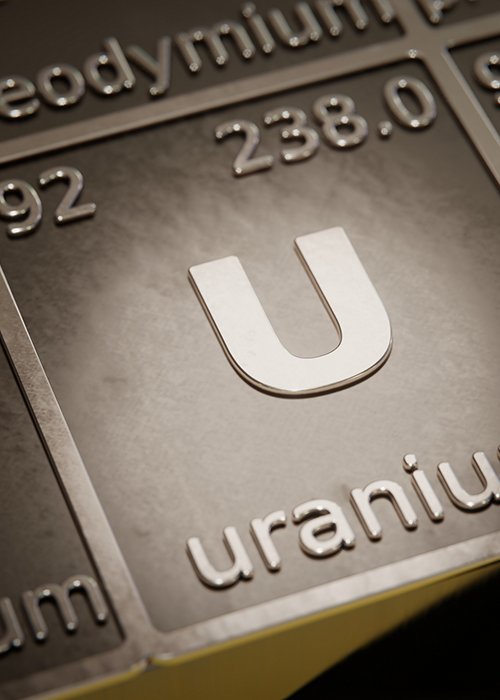Uranium is a heavy metal, with the chemical symbol U and atomic number 92. It’s a naturally occurring radioactive element, found in trace amounts in the Earth’s crust. It’s more common than gold and silver, but less so than aluminium or iron. Its abundance is estimated at around 4 parts per million. In other words, out of a million tiny grains of the Earth’s crust, four are uranium. What makes uranium particularly interesting is its isotopes. Isotopes are atoms of the same element which have the same number of protons (and thus the same atomic number), but a different number of neutrons in the nucleus. This leads to a slightly different atomic mass, meaning the isotope with more neutrons in the nucleus weighs more. In nature, uranium mainly exists in two isotopes, meaning three atomic forms of different weights. It’s still uranium, but made up of either lighter or heavier atoms. Let’s take a closer look. Uranium-238 (²³⁸U) makes up about 99.27% of natural uranium. Uranium-235 (²³⁵U) is the undisputed star of the nuclear world, but accounts for only around 0.72% of natural uranium. It’s lighter than uranium-238 and is the only fissile uranium isotope occurring naturally. So, it’s the nuclear fuel that powers nuclear power plants – and, unfortunately, also nuclear bombs. The aim of uranium enrichment is to increase the proportion of uranium-235 relative to uranium-238. This is because, as we’ve seen, only U-235 is fissile and able to sustain the chain reaction required for energy production in nuclear reactors. The fundamental principle of enrichment relies on the tiny mass difference between uranium isotopes. Atoms of ²³⁵U are slightly lighter than those of ²³⁸U. Although the difference is minimal, it’s enough to be exploited in large-scale industrial processes. Before enrichment, mined uranium is reacted with fluorine and converted into a gaseous compound called uranium hexafluoride (UF₆). This gas is the only form of uranium that can be easily used in the main enrichment methods. Gas centrifugation is today the most common and efficient method for enriching uranium. It exploits centrifugal force to separate the isotopes. Gaseous UF₆ is fed into long, narrow cylinders called centrifuges, which spin at incredibly high speeds – tens of thousands of revolutions per second. The centrifugal force pushes the heavier molecules containing U-238 towards the outer wall of the cylinder, while the lighter molecules with U-235 tend to remain closer to the centre. Inside the spinning cylinder, the gas forms distinct layers. A pump extracts the slightly enriched gas from the centre of the centrifuge, and the slightly depleted gas from the outer edge. A single centrifuge only achieves a modest degree of enrichment. To reach the desired levels, thousands of centrifuges are connected in parallel and series cascades. The slightly enriched material from one centrifuge passes to the next, and so on, until the required concentration is achieved.



